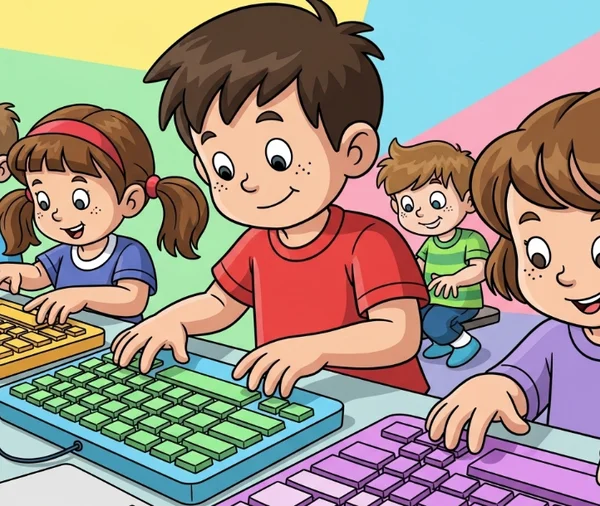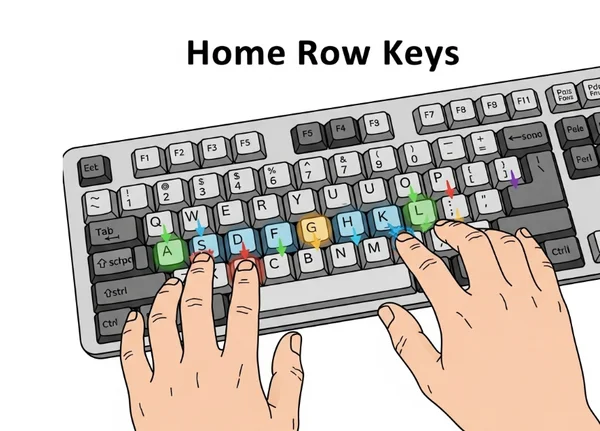Kelajuan Menaip Purata Pelajar: Penanda Aras & Petua Meningkatkan
Dalam dunia digital hari ini, kelajuan menaip adalah penting untuk pelajar. Ibu bapa dan pendidik sering tertanya-tanya, Berapakah PPM yang baik untuk pelajar berusia 12 tahun? Serta, bagaimanakah cara untuk membantu pelajar muda meningkatkan kemahiran mereka? Panduan ini memberikan pandangan tentang PPM purata untuk pelajar, penanda aras mengikut umur, dan petua praktikal untuk latihan menaip kanak-kanak yang berkesan. Memahami aspek-aspek ini boleh membantu dengan ketara dalam membangunkan kelajuan menaip pelajar yang penting. Mari kita lihat di mana kedudukan pelajar anda? Uji kelajuan menaip pelajar sekarang dan temui cara yang diperibadikan untuk meningkatkan!
Memahami PPM Purata Pelajar Mengikut Tahap Gred

PPM mengikut umur yang diketahui membantu menetapkan matlamat yang realistik untuk pelajar. Walaupun kemajuan individu berbeza-beza, penanda aras umum menawarkan konteks yang berharga untuk menjejaki perkembangan dalam kemahiran menaip papan kekunci.
Kepentingan Kemahiran Menaip untuk Pelajar Muda
Membangunkan kemahiran menaip yang baik sejak awal memberi banyak manfaat kepada pelajar. Ia meningkatkan keupayaan mereka untuk menyiapkan tugasan dengan cekap, melibatkan diri dalam penyelidikan dalam talian, dan mengambil bahagian dalam persekitaran pembelajaran digital. Kecekapan menaip yang kukuh boleh mengurangkan kekecewaan dengan tugasan berasaskan komputer dan membebaskan tenaga mental untuk fokus yang lebih mendalam pada kandungan dan pembelajaran. Apabila tuntutan akademik meningkat, kelajuan menaip pelajar yang kukuh menjadi aset yang ketara.
Penanda Aras Kelajuan Menaip Sekolah Rendah (Gred 3-5)
Untuk pelajar di sekolah rendah (biasanya gred 3-5, umur 8-11), tumpuan sering diberikan kepada mempelajari susun atur papan kekunci dan membangunkan ketepatan asas. PPM purata mungkin berjulat daripada 10-20 PPM. Pada peringkat ini, ketepatan menaip pelajar adalah lebih kritikal daripada kelajuan mentah. Memperkenalkan pelajaran menaip yang menyeronokkan boleh menjadikan proses pembelajaran menyeronokkan.
Jangkaan Kelajuan Menaip (Gred 6-8)
Menjelang sekolah menengah (gred 6-8, umur 11-14), pelajar dijangka mempunyai kelajuan menaip yang lebih berfungsi. PPM purata untuk pelajar dalam kumpulan ini sering jatuh antara 20-35 PPM. Soalan seperti, "Berapakah kelajuan menaip purata untuk pelajar gred 7?" adalah perkara biasa. Mereka sepatutnya selesa dengan menaip sentuh dan mampu menaip tugasan dengan kecekapan yang munasabah. Latihan menaip kanak-kanak yang konsisten adalah kunci di sini.
Sasaran Kelajuan Menaip (Gred 9-12)
Pelajar sekolah menengah atas (gred 9-12, umur 14-18) yang bersedia untuk kolej atau kerjaya masa depan harus menyasarkan kelajuan menaip pelajar yang lebih tinggi. PPM purata 35-50+ PPM adalah sasaran yang baik. Pada peringkat ini, menaip yang cekap adalah penting untuk kertas penyelidikan, esei, dan ujian piawai yang mungkin mempunyai komponen penulisan bermasa. Menggunakan ujian PPM untuk pelajar boleh membantu mereka menjejaki kemajuan mereka.
Teknik Latihan Menaip Kanak-kanak yang Berkesan
Membantu kanak-kanak meningkatkan kelajuan menaip memerlukan gabungan latihan berstruktur dan aktiviti yang menarik. Bagaimanakah saya boleh membantu anak saya menaip dengan lebih pantas?,
Menjadikan Pelajaran Menaip Menyeronokkan dan Menarik
Untuk memastikan pelajar muda bermotivasi, pelajaran menaip harus menyeronokkan. Pertimbangkan untuk menggunakan:
-
Permainan menaip dalam talian: Banyak platform menawarkan pelajaran yang digamifikasi yang menjadikan pembelajaran terasa seperti bermain.
-
Menaip berasaskan cerita: Menaip cerita pendek atau fakta menyeronokkan boleh menjadi lebih menarik daripada latihan huruf rawak.
-
Ganjaran positif: Raikan kemenangan kecil dan kemajuan untuk membina keyakinan. Matlamatnya adalah untuk menjadikan latihan menaip sesuatu yang mereka nantikan.

Kepentingan Asas Menaip Sentuh
Mengajar teknik menaip sentuh yang betul dari awal adalah penting. Ini termasuk:
-
Penempatan jari yang betul pada baris rumah.
-
Menggunakan semua jari, bukan hanya beberapa.
-
Memastikan mata pada skrin, bukan papan kekunci. Penguasaan asas ini akan meningkatkan kelajuan dan ketepatan menaip pelajar dalam jangka masa panjang. Anda boleh lawati wpmtest.cc untuk sumber latihan untuk mengukuhkan kemahiran ini.

Menetapkan Matlamat Realistik dan Menjejaki Kemajuan untuk Kelajuan Menaip Pelajar
Bekerja dengan pelajar untuk menetapkan matlamat PPM mengikut umur yang boleh dicapai. Penggunaan ujian menaip secara berkala membolehkan mereka melihat peningkatan, yang menjadi motivator yang hebat. Raikan peristiwa penting, sama ada mencapai sasaran PPM baharu atau mencapai ketepatan yang lebih tinggi. Maklum balas yang konsisten membantu memperhalusi kemahiran menaip papan kekunci mereka.
Menggabungkan Sesi Latihan Singkat dan Kerap
Daripada sesi yang panjang dan jarang berlaku, galakkan latihan menaip kanak-kanak yang pendek dan kerap. Latihan fokus selama 10-15 minit setiap hari boleh menjadi lebih berkesan daripada satu jam seminggu. Ini membantu membina memori otot dan menghalang pelajar daripada berasa terharu. Adakah, permainan menaip berkesan untuk kanak-kanak? Ya, terutamanya apabila digunakan secara konsisten sebagai sebahagian daripada rutin latihan yang pelbagai.
Alat dan Sumber untuk Menyokong Peningkatan Menaip
Nasib baik, banyak alat menaip pendidikan tersedia untuk membantu pelajar meningkatkan kemahiran menaip mereka.
Menggunakan Platform Ujian Menaip Dalam Talian
Platform yang menawarkan ujian PPM untuk pelajar adalah sangat berguna. Mereka menyediakan:
- Teks piawai untuk latihan.
- Maklum balas PPM dan ketepatan serta-merta.
- Keupayaan untuk menjejaki kemajuan dari semasa ke semasa. Ini membantu pelajar memahami kelajuan menaip pelajar semasa mereka dan bidang untuk penambahbaikan. Ujian kelajuan menaip dalam talian kami adalah tempat yang baik untuk bermula.
Mencari Permainan dan Perisian Menaip yang Sesuai dengan Umur
Banyak permainan menaip dalam talian direka khusus untuk kumpulan umur yang berbeza, menjadikan pembelajaran interaktif dan menyeronokkan. Cari perisian atau permainan yang memberi tumpuan kepada kelajuan dan ketepatan, dan menawarkan tahap kesukaran yang progresif. Ini memastikan latihan menaip untuk kanak-kanak kekal mencabar namun boleh dicapai.
Penglibatan Ibu Bapa dan Pendidik: Galakan dan Bimbingan
Sokongan daripada ibu bapa dan pendidik memainkan peranan yang penting. Memberi galakan, membantu menyediakan persekitaran latihan yang selesa, dan meraikan kemajuan boleh membuat perbezaan yang besar dalam perjalanan anak untuk meningkatkan kelajuan menaip mereka untuk kanak-kanak. Memahami penanda aras menaip yang perlu dicapai pelajar sekolah rendah atau sekolah menengah membolehkan bimbingan yang lebih berkesan.

Membina Asas untuk Kejayaan Masa Depan dengan Kemahiran Menaip
Membangunkan kelajuan dan ketepatan menaip pelajar adalah pelaburan penting untuk kejayaan akademik dan profesional anak. Dengan memahami penanda aras purata, menggunakan strategi latihan yang berkesan, dan menggunakan sumber yang berguna, pelajar boleh meningkatkan kemahiran menaip papan kekunci mereka dengan ketara. Ingat, kesabaran dan usaha yang konsisten adalah kunci.
Apakah cara kegemaran anda untuk menggalakkan latihan menaip kanak-kanak? Kongsikan petua anda dalam komen di bawah!
Kelajuan Menaip Purata untuk Pelajar
Berikut adalah jawapan kepada beberapa soalan lazim mengenai PPM purata untuk pelajar.
Berapakah PPM yang baik untuk pelajar berusia 12 tahun?
PPM yang baik untuk pelajar berusia 12 tahun (biasanya gred 6 atau 7) adalah antara 25-35 PPM dengan ketepatan tinggi (90%+). Walau bagaimanapun, ini boleh berbeza-beza berdasarkan pengalaman dan latihan mereka. Tumpuan harus diberikan kepada peningkatan yang stabil dan teknik yang baik. Anda boleh membantu anak anda berlatih di sini untuk mencapai matlamat ini.
Bagaimanakah saya boleh membantu anak saya menaip dengan lebih pantas?
Untuk membantu anak anda menaip dengan lebih pantas, galakkan mereka berlatih secara tetap dengan memberi tumpuan kepada asas menaip sentuh. Jadikan latihan menyeronokkan dengan permainan menaip, tetapkan matlamat yang realistik, dan pastikan mereka mempunyai persediaan yang selesa. Pengukuhan positif untuk peningkatan dalam kelajuan dan ketepatan juga penting. Menggunakan alat latihan menaip dalam talian boleh membantu menjejaki kemajuan.
Adakah 30 PPM bagus untuk pelajar berusia 10 tahun?
Ya, 30 PPM boleh dianggap baik untuk pelajar berusia 10 tahun (kira-kira gred 4 atau 5), terutamanya jika digabungkan dengan ketepatan yang baik. Pada usia ini, ramai yang masih membangunkan kemahiran menaip papan kekunci asas mereka. Latihan menaip untuk kanak-kanak yang konsisten dan menyeronokkan akan membantu mereka meningkatkan lagi.
Berapakah kelajuan menaip purata untuk pelajar gred 7?
Kelajuan menaip purata untuk pelajar gred 7 (kira-kira 12-13 tahun) biasanya berada dalam julat 25-40 PPM. Sesetengah mungkin lebih pantas dengan latihan khusus. Adalah penting mereka juga mengekalkan ketepatan yang baik. Penilaian PPM pelajar boleh memberikan penanda aras yang jelas.
Bagaimana untuk menjadikan latihan menaip menyeronokkan untuk pelajar?
Jadikan latihan menaip menyeronokkan untuk pelajar dengan menggabungkan permainan, pertandingan yang bersesuaian, dan kandungan yang pelbagai. Biarkan mereka menaip tentang topik yang mereka gemari. Gunakan permainan menaip dalam talian yang berwarna-warni dan menarik dan raikan pencapaian mereka untuk memastikan mereka bermotivasi. Cari sumber untuk latihan menaip yang menyeronokkan di tapak kami.